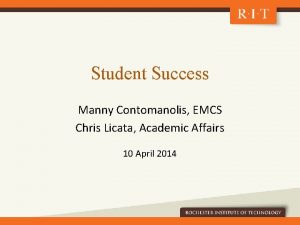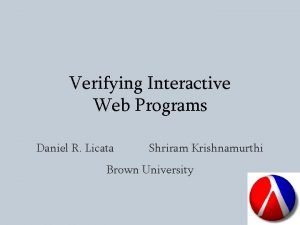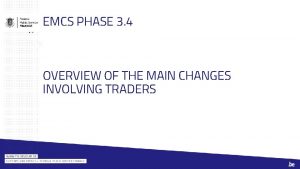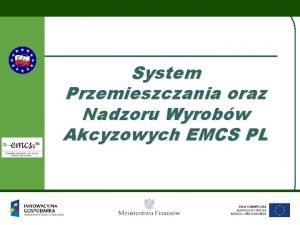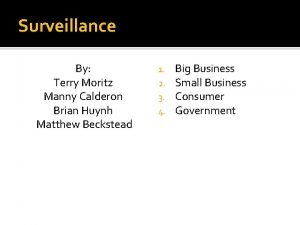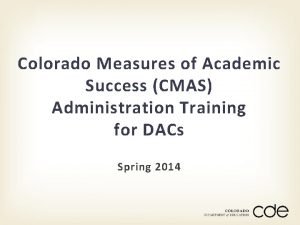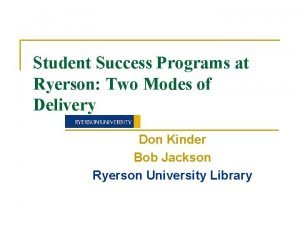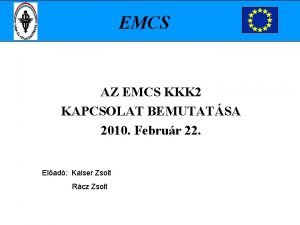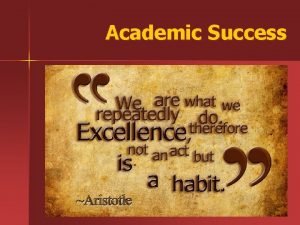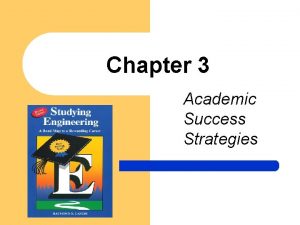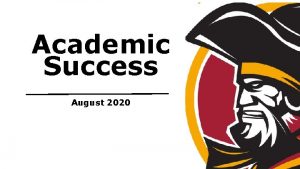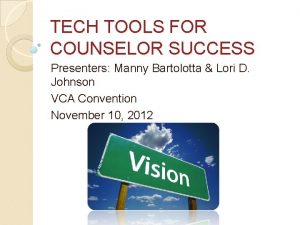Student Success Manny Contomanolis EMCS Chris Licata Academic














- Slides: 14

Student Success Manny Contomanolis, EMCS Chris Licata, Academic Affairs 10 April 2014

Student Success: The RIT Experience Retention to on-time graduation Driving Focus: Innovative integration T-shaped professional Engage and transform students for a lifetime of professional and personal growth and success. Establish and promote a culture of on time graduation for undergraduate and graduate students. Strategies Under Discussion • • The “Graduation Compact” The 3 P’s of on-time graduation – Principles, Policies, Practices Curricular “T” – Academic Depth; Professional and Personal Breadth Co-Curricular “Jungle Gym” The Successful RIT Graduate Career Advancement and Satisfaction – Engaged Citizenship – Personal Growth

Diversity Sharon Mason, GCCIS Kevin Mc. Donald, Diversity & Inclusion 10 April 2014

Inclusive Excellence Framework Areas Access and Success • Women and AALANA Male Students ü Pipeline explorations/Student Success rec. • AALANA and Women Faculty ü Recruitment strategies (cluster hires) • Women and AALANA staff and faculty retention/advancement ü Leadership development/career ladder/career pathing programs ü Use of data from faculty/staff exit interviews Education & Scholarship • Global diversity perspective infused into curriculum with recognition of the importance of domestic and international perspectives (multicultural & international) üCurrent efforts are on right track with the need to reinforce the aforementioned Campus Climate and Intergroup Relations • Use of survey and focus group assessments to gauge impact of efforts and existing sentiments and needs from constituency groups üCampus Inclusion Index üExisting surveys üDisaggregated data Institutional Infrastructure • Increased compositional diversity in leadership üGlaring need with support mechanisms needed when hires are made üMulticultural alumni engagement üOpportunity for greater inclusion • Inclusive policies üProgress made - more needed

Research and Graduate Education Callie Babbit, GIS Vicki Hanson, GCCIS 10 April 2014

Key RGE Themes: § Research at RIT is still in early phases of growth • • § Investment has to be strategic and focused • • § Current research strengths Emerging funding trends and societal / industry needs Opportunities for transformation and growth towards high impact Advancement of strategic areas requires top-down support and structure • • § Catalyze advancement of strategic interdisciplinary research strengths Engage faculty and students from core disciplinary programs that bridge fundamental research and strategic strengths Strategic areas must be identified at the intersection of faculty input and institutional successes • • • § Needs substantial and sustained investment and time to mature “ROI” has to be measured inclusively (beyond cost) Encourage and reward interdisciplinarity Remove barriers to collaboration Advancement of strategic areas requires a creative and intellectual environment • • Culture of research and innovation Quality of work life for faculty and graduate students

Questions (RGE) 1. What metrics of performance define success in Research and Graduate Education at RIT? 2. What is the motivation for having research-oriented programs at RIT and what are the main benefits • For RIT as an institution? • For RIT students (those directly engaged in research and those who may benefit indirectly)? 3. What kinds of graduate programs and research foci have the most potential to enhance the RIT brand? 4. What skills and qualities would a student with research experience have that are valued by employers (compared to a student with only coursework)? 5. What external trends, threats, and opportunities are most likely to impact development of research and graduate education at RIT?

Global Engagement and International Education Zack Butler, GCCIS Jim Myers, Academic Affairs 10 April 2014

Global Engagement and International Education: Guiding Principles • Comprehensiveness: RIT is committed to pursuing comprehensive internationalization. • Faculty leadership: RIT is committed to a model of internationalization achieved through faculty leadership and engagement. • Academic excellence: RIT is committed to attaining high standards of ethical academic performance in international education. • Engagement: RIT is committed to a model of international education that requires and supports active engagement with people from different cultures, races, and ethnic and socio-economic backgrounds. • Student Centered Inclusiveness: RIT is committed to developing international learning experiences and academic programs that are student centered, inclusive, and accessible to all students regardless of race, ethnicity, sex, gender, religion or socioeconomic status.

Global Engagement and International Education Three major goals – Curriculum & Learning outcomes: Every RIT student will have global/multicultural/international learning outcomes and experiences in both their general education & professional curriculum. – Programs: RIT will become a distinguished international university by creating a select group of unique academic programs focusing on global professional practice and international expertise. – Engagement: RIT’s international education learning outcomes, and its international reputation, will be materially enhanced by strategically supporting international research partnerships, establishing select programs in emerging international centers of excellence and enabling innovative ways of educating international students.

Organizational Agility Amit Ray, COLA Howard Ward, F & A 10 April 2014

OA Definition and Action Items 1. Clear and universally understood definition of RIT’s identity and strategic direction. 2. Any expansion/restructuring is based on this shared direction—real interdisciplinarity; fix silos. 3. Budgetary decentralization and transparency; space centralization; financial flexibility—stop running on the margin, take risks, minimize compliance bureaucracy. 4. Curricular flexibility (tied to financial flexibility). 5. Empower those who have authority to make local decisions. 6. Respect/faith/trust across the RIT community.

Curricular Innovation and Creativity Deb Blizzard, CLA Neil Hair, ILI 10 April 2014

Curricular Innovation and Creativity How do we create a structure and culture that supports and promotes an innovative curriculum grounded in creativity? Our work consists of nothing less than: • Fostering a student-centered culture of teaching, in addition to research. • Increasing opportunities for cross-disciplinary teaching and learning experiences. • Recognizing and supporting the noble motivations of teachers, students, alumni and the community. • Reorienting our culture to tolerate risk and to celebrate experimentation. • Identifying and minimizing organizational barriers and inertia. • Deploying learning technologies that prioritize the needs of users first. • Seeing students as companions on a journey toward a meaningful life. We welcome your questions around specific implementation directions currently under study.
 Manny contomanolis
Manny contomanolis Rit academic success center
Rit academic success center Nicola licata
Nicola licata Daniel licata
Daniel licata Emcs rendszer
Emcs rendszer Helpdesk emcs kontakt
Helpdesk emcs kontakt The schwa was here chapter 1 summary
The schwa was here chapter 1 summary Julian beever biografia
Julian beever biografia Manny beckstead
Manny beckstead Summary of diary of a wimpy kid hard luck
Summary of diary of a wimpy kid hard luck Academic success center
Academic success center Continuing academic success
Continuing academic success Student success center iowa state
Student success center iowa state Cmas test nav
Cmas test nav Ryerson academic success centre
Ryerson academic success centre

